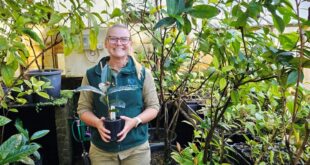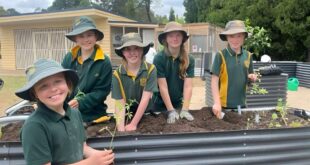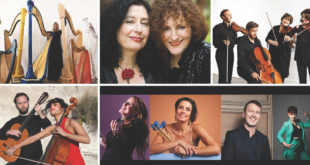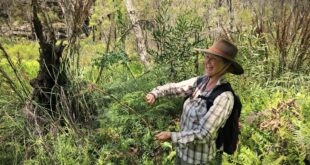
A healthy wombat. (Supplied)
These hairy, furry balls of cuteness are one of Australia’s most appealing animals, but many wombats are dying painful deaths from an infectious parasite. We joined the volunteers on a mission to save local wombats.
Key Points:
- Mange is a parasite that proves fatal to wombats if left untreated and is decimating immunocompromised wombat populations after the recent drought, fire and floods.
- The Blue Mountains Wombat Conservation Group is working to save wombats in the Megalong Valley but relies on donations of lids and corflute, and financial donations for the heavy cost of the Moxidectin treatment and the much-needed fauna cameras. They are also keen to attract more volunteers.
Share this article:
It feels like a covert operation. We’re dressed in sturdy shoes and warm clothes on a chilly day in the Megalong Valley, armed with makeshift poles to administer emergency treatment to sick wombats.
I’m instructed to be as quiet as possible. It’s the middle of the day but we can’t risk scaring the wombats away. It’s vital they get their treatment if they have any hope of survival.
Melina Budden, founder of the Blue Mountains Wombat Conservation Group, is leading me and another volunteer. It’s part of a weekly ritual, volunteers making the downward trek from the upper Blue Mountains far into the dirt roads of the Megalong Valley.

Wombat Veronica sadly could not be saved. She died of renal failure not long after this photo was taken. (Supplied)
Here in the Valley, Melina and her team have named each of the wombats as they attempt to slow the spread of mange, a parasite that proves fatal to wombats if left untreated.
Today we’re expecting to see Eve, a wombat they successfully treated two years ago, now in danger again.
On cue, beautiful but bedraggled Eve appears just as Melina said she would. While we think of wombats as nocturnal creatures, they’re now venturing out in daylight for food, malnourished by the mange.
As Eve tentatively lumbers towards us, Melina remarks that she’s looking improved. To me, she still seems crusty and rough around the edges; a far cry from a postcard-cute wombat.
Anyone who’s encountered a wombat with mange will be familiar with the look: they’re often flyblown, with raw skin where they’ve been scratching and sometimes bloody, open wounds.
What’s less obvious is that they’re also dying from secondary infections, severe malnourishment, renal failure or from being hit by vehicles due to failing sight and hearing loss caused by mange.
As Melina approaches holding the pole and scoop filled with the chemical Moxidectin to treat the wombat from a distance, Eve lollops away, dodging the cure that could save her life.

Melina Budden treating wombats with the ‘pole & scoop’ method. (Supplied)
Eventually Melina catches up with her and Eve gets two doses, but she will need more.
It’s difficult to combat mange in the wild because wombats need a series of treatments, not just one. In total, each wombat requires a weekly dose for fifteen weeks, making it a costly and labour-intensive process.
A zoologist, Melina travels weekly from Sydney while juggling paid jobs and a PhD. The work can be challenging at times – scrambling around uneven terrain trying to find mange-inflicted wombats and keeping a rigorous record of treatment.
As well as the pole and scoop method, the volunteers place corflute flaps – made from old real estate signs – at each burrow and pour the Moxidectin into a recycled plastic jar lid above the flap. When a wombat ventures in or out of the burrow, the treatment spills onto them.
Afterwards, Melina and the crew check the fauna cameras that track the wombats’ movements day and night, making note of who got the flap treatment and how many times.

Melina Budden and fellow volunteer Freya Carnie check the fauna cameras. (Liz Durnan)
The mange is so infectious they put flaps at every burrow they find within a one-kilometre radius of an affected wombat so that every wombat is treated.
“We always try to treat the whole population,” Melina says, “because an infected wombat will bring it back to the burrow and spread it everywhere.”
While it might seem like a makeshift process, it’s still the tried and tested method used around the state by wildlife groups and volunteers.
But Melina sees it as a short-term solution: “Essentially we’re just buying time,” she says. “It’s a band aid.”
There are other species of wombat with diminished numbers: the northern hairy-nosed wombat, now only found in Queensland, is officially endangered and the southern hairy-nosed wombat, found in South Australia, is classified as near-threatened. The population of bare-nosed wombats in Tasmania declined by more than 80% after a sarcoptic mange outbreak.
Today we’re dealing with the bare-nosed wombat, formerly known as the common wombat. While Melina tells me there are calls to get this wombat listed under the IUCN red list of threatened species, there’s no official agreement on the threat level it currently faces.
Last year though, the NSW Government earmarked $2.8 million to address mange.
Melina hopes that community groups like hers will receive a fraction of the funding. “It’s community groups that are doing the work on the ground to tackle the issue,” she says.
Meanwhile, her group relies on donations of lids and corflute, and financial donations for the heavy cost of the Moxidectin treatment and the much-needed fauna cameras.

Volunteers Freya Carnie and Melina Budden checking the flaps at a wombat burrow. (Liz Durnan)
She would also love to see more research into the reason why sarcoptic mange is affecting wombats so severely. The mange is also known as scabies, a parasite introduced by European settlers and their animals. It affects other animals, including humans, dogs, and kangaroos, but doesn’t usually kill them. It’s a different story for wombats, but no one knows why.
While mange isn’t a new issue for wombats, Melina tells me the situation is particularly dire right now due to a series of extreme environmental events, such as drought, bushfires, then multiple floods, causing them to become severely immunocompromised.
In addition to lack of research and funding, volunteers can sometimes face resistance from landowners and farmers, who have traditionally seen wombats as pests.
While it’s true that a combination of land clearing and wombat burrowing can cause damage to farming land and infrastructure, the wombats have a positive function. Melina reports that some farmers are becoming more sympathetic to their plight:
“I call them the engineers of the environment,” Melina says. “Yes, they make a hole, but they’re improving the soil health by allowing the continuation of the soil nutrient cycle.”
As well as much needed funds, the Blue Mountains Wombat Conservation Group is always on the lookout for volunteers.
“We’re going to have to expand because this is the worst we’ve ever seen it and we’re having to go back to areas we already treated three years ago.”
Despite the naming and bonding, Melina is keen to seek volunteers looking for more than a “selfie with a cuddly wombat.” The work is rewarding though, and they ask for a regular commitment of just a couple of days each month. The group now comprises around 40 volunteers.

After weeks of treatment, Eve is clear of mange but needs to regain her weight and hair. (Liz Durnan)
Despite the difficulties, Melina is motivated to keep going by the small wins they see each week. They regularly document these on their social media accounts to gain support for the cause. “If one person tells ten people and those ten tell another ten, it will have a ripple effect,” she says.
While there’s no consensus among wildlife groups and scientists on exactly how much trouble wombats face, Melina urges fast action before it’s too late, citing inaction on other species leading to disaster.
“There have been many common species in Australia, and we thought we didn’t need to intervene,” she says.
“But we see these once common species, like the Greater Glider, going from common to endangered in one fell swoop and we shouldn’t be waiting until they’re in danger before we intervene.”
Take Action:
- Find out more or join the Facebook group: The Blue Mountains Wombat Conservation Group Facebook page
- Donate: https://gofund.me/5712b6e7
- Find out more about wombat mange: The Wombat Protection Society
- Listen to this fascinating podcast from Voice of Real Australia ‘Why Wombats are Rotting to Death’
Share this article:
This story has been produced as part of a Bioregional Collaboration for Planetary Health and is supported by the Disaster Risk Reduction Fund (DRRF). The DRRF is jointly funded by the Australian and New South Wales governments.

More from around the region
Maligned through the ages for their association with witchcraft, disease, drug use and poisonings, the fungus kingdom is gaining due credit thanks to ecologists, photographers and foragers. Read more in Katoomba Area Local News (link in profile):
https://www.katoombalocalnews.com/fungi-of-the-upper-blue-mountains/
#fungi #fungus #mycelium #fantasticfungi #bluemountains #planetaryhealth #katoomba #foraging #fungiforaging #fungiphotography #ecology
Yesterday we interviewed physicist Emeritus Professor Hans Coster at Middle Earth in Lithgow. He was in charge of the Sydney Chapter of the Club of Rome and we can`t wait to share with you everything we learnt when we visited him in the home he`s built into a hill in Lithgow. Subscribe to our newsletter via any of our news sites to make sure you get this story! Link in profile.
#nickelironbatteries #middleearth #planetaryhealth #hanscoster
Inspiring reading and a video of Harry Laing`s mesmerising performance of `Time of Fire` in the Blue Mountains Planetary Health newsletter (link in profile): https://bit.ly/3UyytbE
Subscribe to receive this fortnightly via any of our news sites:
Katoomba Area Local News: Fungi of the Upper Blue Mountains
Mid Mountains Local News: The Fun Guy: Earth Rising Mushroom Farm in Lawson
Blackheath Area Local News: A Carnival of Camellias: Beauty and Biodiversity at the Blue Mountains Botanic Garden
Springwood Area Local News: Springwood Lot Party: Transforming an Underused Space Into a Vibrant Community Event
Lower Mountains Local News: Women Helping Women to Survive and Thrive
Lithgow Local News: Fabulous Fungi in Lithgow & the Blue Mountains
@botanicsydney @zontaclubbluemountains
#fungi #fantasticfungi #camellias #zonta #camelliasinensis #springwood #harrylaing #timeoffire
With a bit of tweaking we can reduce how much we need to spend on water and energy. Blue Mountains libraries now stock free-to-borrow ‘My Energy and Water Saver’ kits that Blue Mountains residents can use to assess their homes for energy and water efficiency. Belle Butler borrowed one of the kits and discovered some room for improvement in her Lawson home. Read more in Mid Mountains Local News (link in profile) https://www.midmtnslocalnews.com/saving-power-with-take-home-kits/
@bluemountainscitycouncil
#energyefficiency #waterefficiency #savemoney #savetheearth #freeresource #librariesrock #takeaction #planetaryhealth
Blackheath Public School is providing hands-in-the-dirt lessons on how students can make their school more sustainable. From Crunch & Sip to Cluckingham Palace – literally! – organic waste makes the sunflowers shine and worms frolic in the fertile compost. Students will soon be eating spinach and cheese scrolls made by the canteen using garden produce, while parents report their children want to eat more vegetables. Read more in Blackheath Area Local News (link in profile): https://blackheathnews.com/sustainability-at-school/
blackheathpublic_pandc #blackheathpublicschool #blackeath #bluemountains #sustainableschools #schoolgardens #schoolgardensmatter #planetaryhealth
A fun day yesterday for @bluemountainsplanetaryhealth! In the morning we interviewed and filmed the young people in our Upcycling Fashion Skillshare program. They`re helping create the circular economy we need. In the afternoon we ran a workshop on media skills to help another group of young people learn how to create the news we need, and the news they want to see! They learnt how to use green screen and teleprompter technology as well as skills for interviewing and presenting the news. We`re looking forward to sharing the outcomes! Thank you @heli.jones @kalanigacon @kfmmedia #solutionsmedia #thenewsweneed #upcyclingfashion #planetaryhealth #skillshare #katoomba #bluemountains #pluriversity
Such a fabulous day working with a great bunch of young people to learn how news is made, how green screens work and how to create the news we all need to hear. We can`t wait to see the end result!
#solutionsmedia #thefixingnews #thenewsweneedtohear #greenscreens #mediaproduction #planetaryhealth #skillshare
For over 45 years the Springwood Neighbourhood Centre Co-operative has been providing much needed community resources, advice and facilities to the people of the Blue Mountains. Tonje Akerholt and the other staff at the Centre work tirelessly to ensure that the space continues as somewhere everyone can feel welcome and connected, and they offer a fascinating range of volunteer opportunities. Read more in Springwood Area Local News (link in profile):
https://springwoodlocalnews.com/springwood-neighbourhood-centre/
@centre2777 #springwoodneighbourhoodcentre #neighbourhoodcentre #communitycentres #springwood #bluemountains #communitytogether #planetaryhealth
As our ageing infrastructure begins to fail in the face of extreme weather events, the Blue Mountains Planetary Health Initiative is bringing together international experts to ’talk infrastructure` at 10am next Tuesday 23 April.
In 2016 Dr Penny Burns and a group of global asset managers created the Talking Infrastructure Association to focus on improving infrastructure decision making around the world, including developing tools and techniques to ensure that new infrastructure projects will survive the coming changes in technology, demand and climate change - that is, that they will be ‘future friendly’.
Next Tuesday, Ruth Wallsgrove from the UK, a board member of Talking Infrastructure, and a global leading Asset Manager trainer who has trained thousands of people to date on five continents, will join other board members, Dr Penny Burns from South Australia, and Jeff Roorda from Blue Mountains City Council, to look at lessons learned from the last 40 years of asset management that can help us meet the challenges of the next 40 years. Amongst other things, Ruth created the Women in Asset Management North America Network. She will bring to the discussion a long career in asset-intensive industries including water & waste water, rail, power, and cities, in both major government and commercial organisations.
Join us at the Planetary Health Precinct as we discuss the urgent changes needed in our mindsets around assets and the tools we need going forward to protect planetary health and biodiversity, and build climate change resilience.
The event is free but bookings essential (link in profile):https://bit.ly/4aD7bpT
#fitforthefuture #assetmanagement #talkinginfrastructure #planetaryhealth
The Story of Asset Management: Coming up at the Planetary Health Precinct 10am-12noon Tuesday 23 April
As we work at recovering from yet another extreme weather event the question many of us are asking is how do we ensure fit-for-purpose infrastructure in a world that is changing in many ways? This month it is 40 years since Dr Penny Burns developed the engineering-economics hybrid we now know as Asset Management. From 1994 to 2014 her newsletter ‘Strategic Asset Management’ became a beacon in the industry. In 2016 Penny set up Talking Infrastructure with Jeff Roorda, now Director of Infrastructure & Project Delivery Service at @bluemountainscitycouncil to look to the future of Asset Management. Join them for a discussion at the Planetary Health Precinct. They`ll discuss the need for a shift from grey to blue and green assets and address the critical question: we can afford to buy it, but can we afford to keep it?
Join us for this very important discussion. This event is free but bookings essential (link in profile):
https://www.eventbrite.com.au/e/talking-infrastructure-40th-anniversary-tour-of-australia-and-new-zealand-tickets-875789759747
#infrastructure #greeninfrastructure #assetmanagement #pennyburns #disasterriskreduction #disasterrecovery #fitforthefutureinfrastructure #newparadigms #planetaryhealth #symbiocene
The Rural Clinical School of the The University of Notre Dame in Lithgow, together with the Blue Mountains Planetary Health Initiative, have been introducing first year medical students to rural medicine, Aboriginal Health and Planetary Health. When given hands-on experience in using a thermal imaging camera they were very surprised to see the difference between the temperature of the deep shade under a tree and the temperature of pavers in full sun was 30C!
Read more in Lithgow Area Local News (link in profile):
https://lithgowlocalnews.com/introducing-medical-students-to-planetary-health/
#firstyearmedical #futuredoctors #ruralhealth #aboriginalhealth #planetaryhealth #heatwaves
#heatislandeffect #thermalimaging
For an entire year over COVID lockdowns, Merryl Watkins posted a new bird photo on social media every day. The Blaxland resident wanted to remind people there was still beauty in the world and joy to be found if you stop, look and listen. Her photography obsession captured imaginations both in the Blue Mountains and overseas, raising awareness of endangered wildlife and treating audiences to the fun antics of our feathered friends. Read more in Lower Mountains Local News (link in profile): https://lowermtnslocalnews.com/merryl-watkins/ @merrylwatkinsphotography #birdsofthebluemountains #birdsofaustralia #birdphotographyaustralia #biodiversity #planetaryhealth #blaxland #bluemountains #beauty #resilience #hope





